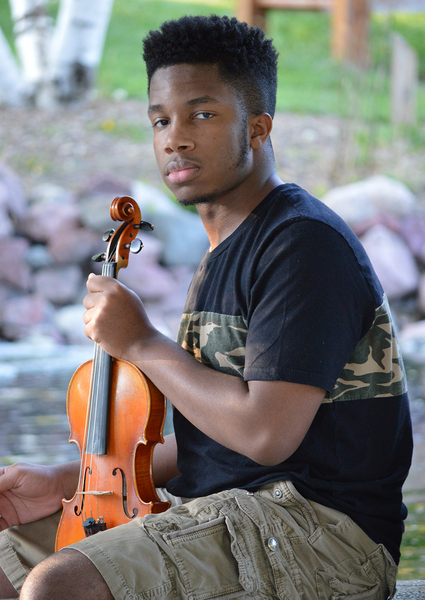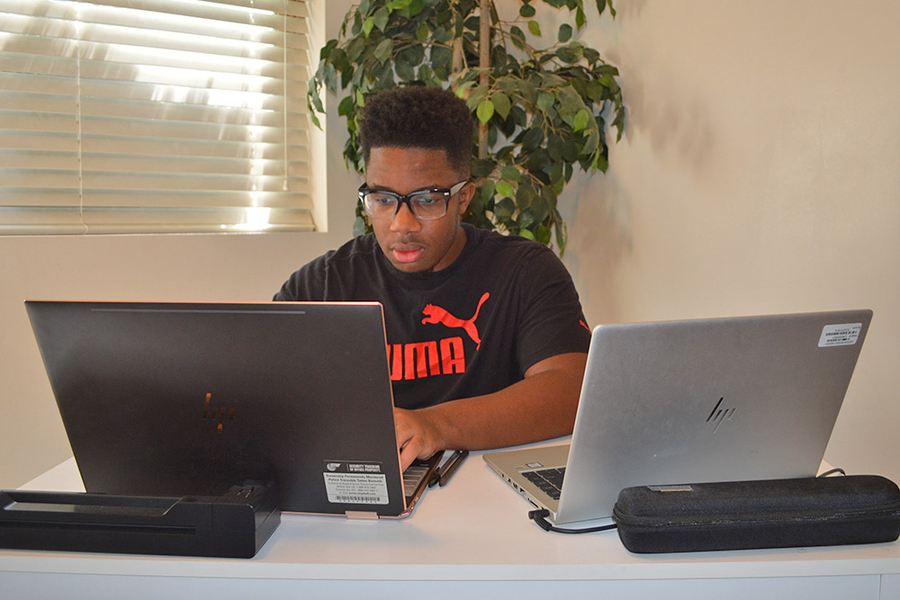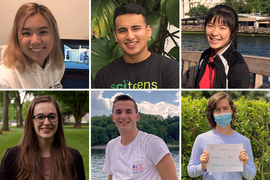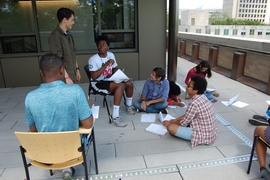Sophomore math major Xzavier Herbert was never much into science fiction or the space program, but his skills in pure mathematics seem to keep drawing him into NASA’s orbit.
With an interest in representation theory, Herbert spent the summer virtually at NASA, studying connections between classical information theory and quantum information theory, each of which corresponds to a different set of laws: classical physics and quantum mechanics.
“What I’m doing involves how representation theory allows us to draw a direct analog from classical information theory to quantum information theory,” Herbert says. “It turns out that there is a mathematical way of justifying how these are related.”
Herbert worked remotely this summer as part of a team of PhD students working to better understand human intelligence and to advance machine learning applications during his internship at the Space Communications and Navigation Internship Project at NASA Glenn Research Center in Cleveland, Ohio, and NASA Goddard Space Flight Center in Greenbelt, Maryland. Under the guidance of NASA employees, he was able to conduct research on quantum information theory and quantum complexity theory.
He trained for real mission scenarios, analyzed powerful space communication systems, used networks software tools, and communicated his findings in a final presentation to NASA management.
It wasn’t his first time working with NASA.
Growing up in Omaha, Nebraska, Herbert discovered his love of math in eighth grade, when he outgrew his school’s math classes and began teaching himself new math concepts. At one point, he asked his teacher whether it was possible to have an exponent with fractions. “My teacher said ‘Yes, but I’d have to remind myself how it worked.’” Instead, Herbert found his answer on Khan Academy, where he also explored algebra and trigonometry. In high school, he took math classes at the local community college, where his mother worked, and at the University of Nebraska, where he was mentored by Professor Griff Elder. “Math kind of flowed for me,” Herbert recalls.
But he had never given much thought to space exploration, until he learned of a fellowship with NASA in his junior year of high school. He performed research at school, as a NASA Space Grant Fellow in 2017-18, and the following year was a NASA Nebraska Space Grant Fellow 2018-19.
The opportunity gave him a chance to flex his math skills, as did his 11th-grade participation in the Haddix STEM Corridor summer research program, where he researched the Navier-Stokes Equation and the Magneto-Hydrodynamic Equation under the guidance of a Creighton University math professor.
MIT was his first choice. “I liked the feel of MIT. It just looks very … mechanical,” he says, laughing. “The other schools looked like a resort.” He said he fit right into campus life last fall, and continued his work as a math tutor and worked as an assistant sports statistician for MIT sports.
When the pandemic sent him home to Omaha in March, he looked for a summer project that would focus on pure mathematics. That’s when a friend of his told him about a NASA internship. Unlike his high school experiences, however, this would be working directly with NASA, instead of from a classroom.
“I was surrounded by outstanding people who were all working together to achieve a common goal. Everyone that I encountered was incredibly passionate about what they did, and I was inspired by how hard everyone worked for achieving a better understanding of space exploration.”
For his project, “Applications of Representation Theory to Quantum Information Theory,” which he worked on with his mentor Alan Hylton, he says he worked on “understanding the core ideas behind quantum information theory and understanding how representations of the symmetric and general linear groups could be used to derive alternate proofs of ideas such as Schumacher’s noiseless encoding theorem and other quantum information theoretic analogues to classical information theoretic ideas.”
His work impressed many at NASA. “Xzavier worked extremely hard to successfully complete his summer internship while adapting to a virtual work environment,” says Molly Kearns, a spokesperson for the NASA internship program. “While Xzavier’s specific position was designed for graduate-level mathematics students, he far surpassed the needed qualifications in terms of mathematics maturity, and was a critical contributing member.”
The experience gave him the idea that he could combine his interest in quantum information theory with a possible future in space communication systems. He hopes to return to NASA next summer, and wouldn’t rule out a career at the space agency someday. For now, however, he’s concentrating on the relationship between representation theory and quantum information theory.
“I hope to begin some work on quantum error correction and/or further understand how representation theory can be used to derive other analogues from classical information theory,” he says. “The elegance of pure math is what led me to study it. I am not really a big fan of problems that have correct solutions, because most times, I don’t find that correct solution on the first attempt. Even though many do not find a valid way of proving a proposition or theorem on the first attempt, there really is no right way to prove something, and that is what I like the most about pure math.”












